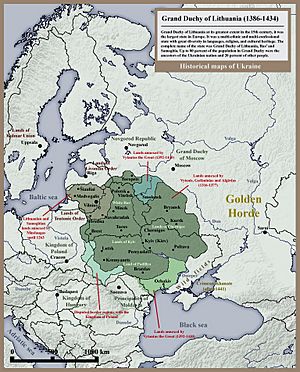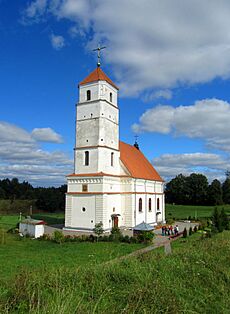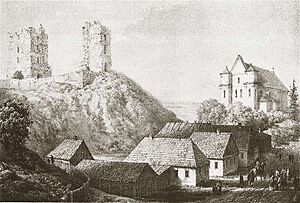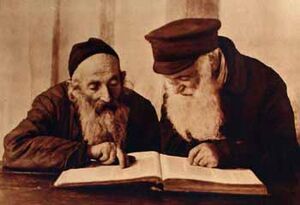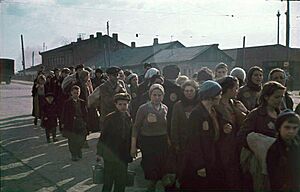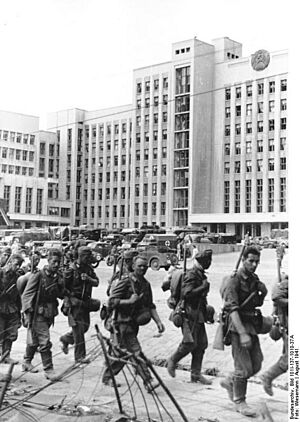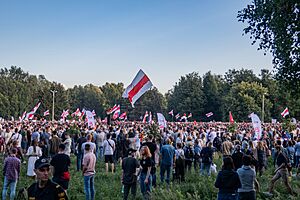History of Belarus facts for kids
The lands of Belarus during the Middle Ages became part of Kievan Rus' and were split between different regional principalities. These included Polotsk, Turov, and Vitebsk. After the Mongol invasions in the 13th century, these lands were taken over by the Grand Duchy of Lithuania. This duchy later joined with Poland to form the Polish–Lithuanian Commonwealth in the 16th century.
Later, in the 18th century, after the Partitions of Poland, Belarusian lands became part of the Russian Empire. After the Russian Revolution, several states fought for control during the Russian Civil War. Eventually, the Byelorussian Soviet Socialist Republic was formed. It became a part of the Soviet Union when the USSR was created in 1922.
Belarus suffered greatly during the German occupation in World War II. After the war, its territory grew when Western Belorussia was given by Poland. Belarus became an independent country in 1991, after the dissolution of the Soviet Union.
Contents
Ancient Times: The First People in Belarus
Archaeological finds show that people lived in what is now Belarus during the Paleolithic (Old Stone Age) and Neolithic (New Stone Age) periods.
Early History: Slavs and Vikings
The story of Belarus truly begins with the movement of Slavic peoples across Eastern Europe. This happened between the 6th and 8th centuries. East Slavs settled in the areas of modern-day Belarus, Russia, and Ukraine. They mixed with local groups like the Baltic and Finnish tribes. This mixing helped create the different East Slavic groups we know today. These early Slavs were pagan farmers who believed in spirits. They traded farm goods, animals, furs, honey, beeswax, and amber.
The modern Belarusian people likely formed from three main Slavic tribes: the Kryvians, Drehovians, and Radzimians. Some Baltic tribes also played a part.
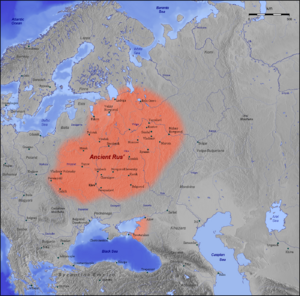
During the 9th and 10th centuries, Varangians, who were Scandinavian Vikings, set up trading posts. These posts were along a busy trade route from Scandinavia to the Byzantine Empire. The many lakes and rivers in East Slavic lands made this trade route very profitable. The Varangians slowly gained control over the Slavic tribes, mainly to improve trade.
The Rus', originally a Varangian tribe, gave their name to the land. They attacked the Byzantine Empire a few times. Eventually, they became allies against the Bulgars. This alliance led to the spread of Christianization and Byzantine culture among the Rus' people.
Eastern Orthodox Christianity and the written Church Slavonic language helped create a new political area. This was Kievan Rus', a loose group of principalities. It was built along old trade routes. Important centers included Novgorod (in Russia), Polotsk (in Belarus), and Kiev (in Ukraine).
Kievan Rus': A Powerful Principality Emerges

Between the 9th and 12th centuries, the Principality of Polotsk became a major power in what is now northern Belarus. The Principality of Turov to its south was less powerful.
Polotsk often showed its independence from other Rus' centers. It became a political capital and a bishop's seat. It also controlled lands among the Balts to the west. The city's Cathedral of the Holy Wisdom (built 1044–66) shows this independent spirit. It was built to rival similar churches in Novgorod and Kiev.
Important cultural figures from Polotsk included the nun Euphrosyne of Polotsk (1120–1173). She built monasteries, copied books, and supported art. This included the famous "Cross of Euphrosyne". Bishop Kirill of Turov (1130–1182) also wrote many sermons and texts in Church Slavonic.
Grand Duchy of Lithuania: A New Power
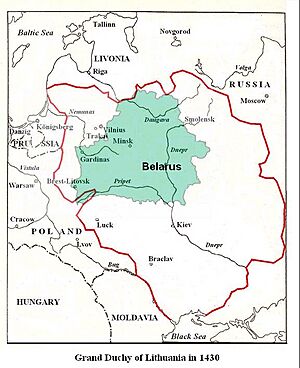
In the 13th century, Kievan Rus' began to fall apart. Attacks from Mongol nomads, especially the sacking of Kiev in 1240, left a power gap. The East Slavs split into many small, competing states. Through wars and marriages, the western Rus' principalities in modern Belarus joined the growing Grand Duchy of Lithuania. This began with Lithuanian King Mindaugas (1240–1263). By the 15th century, most of these lands were part of the Grand Duchy.
Because there were fewer Lithuanians than Ruthenians (later Belarusians and Ukrainians) in this state, the Ruthenians played a big role in daily life. The Ruthenian language was widely used, especially in the eastern and southern parts of the state. This was because most people there were East Slavs and followed the Eastern Orthodox faith.
The East Slavic version of the language, sometimes called Old Belarusian, was the official language of government. It was used in the Grand Duchy of Lithuania from the 14th century until the late 17th century. Then, it was replaced by Polish.
During this time, local languages began to be written down. This was a step in the development of the separate Belarusian, Russian, and Ukrainian languages.
Some Lithuanian rulers, like Švitrigaila, relied on the Eastern Orthodox Ruthenian majority. However, most rulers and powerful nobles started to favor Roman Catholics.
At first, building Orthodox churches was sometimes forbidden in parts of Belarus, like in Vitebsk in 1480. But as the mostly Orthodox Grand Duchy joined with mostly Catholic Poland, things became more open. In 1511, King Sigismund I the Old gave Orthodox clergy the same freedom that Catholic clergy had. This freedom grew in 1531. The Orthodox church became responsible only to its own bishops and the Grand Duke, not to the Catholic bishop.
Because of this, a lively Ruthenian culture grew, especially in the main cities of modern Belarus. Even though Ruthenian was the official language, there wasn't much literature, except for some historical records. The first Belarusian book printed with a printing press was published in Prague in 1517. It was by Francysk Skaryna, a key figure of the Renaissance in Belarus. He later set up a printing press in Polotsk. He published the Bible and other religious works. By his death in 1551, he had published 22 books, helping the Ruthenian language develop into modern Belarusian.
Polish–Lithuanian Commonwealth: A Powerful Union

The Union of Lublin in 1569 created the Polish–Lithuanian Commonwealth. This made it a very important and large country in Europe. While modern Ukraine became part of the Polish Crown, Belarusian lands remained part of the Grand Duchy of Lithuania. Poland, with more people, had more representatives in the parliament. However, the Grand Duchy of Lithuania kept much of its independence. It had its own laws, called the Lithuanian Statutes.
Mogilev was the biggest city in Belarusian lands. Other large cities included Vitebsk, Polotsk, Pinsk, Slutsk, and Brest. Vilna (Vilnius), the capital of the Grand Duchy, also had many Ruthenian people.
Over time, the population didn't change much. Ruthenians usually lived in the countryside. Power was held by local nobles, often of Lithuanian, Polish, or Russian background. Many German Jews also settled here, fleeing persecution. Over time, many nobles became more Polish in culture. This was especially true for powerful families like the Sapieha and Radziwiłł clans. Their wealth was so great that they were like "states within a state." They even founded their own cities and brought in settlers from other parts of Europe.
In the Grand Duchy, peasants had little freedom in the Middle Ages. Nobles slowly took away the few rights of the serfs and increased their taxes. This caused many Ruthenians to flee to less populated areas, like the "Wild Fields" (Dzikie Pola). There, they became part of the Cossacks. Others found safety with other nobles or in Russia.
Religious conflicts also began to appear. Nobles often became Catholic, while common people mostly stayed Orthodox. The Warsaw Compact of 1573 at first protected religious freedom. However, King Sigismund III Vasa, who was very Catholic, tried to spread Catholicism. He supported the counterreformation and the Jesuits.
To avoid conflicts, Orthodox leaders in Kiev signed the Union of Brest in 1595. They broke ties with the Patriarch of Constantinople and joined the Pope. Most Orthodox bishops and the king supported this union. But some important nobles and the growing Cossack movement opposed it. This led to many conflicts and rebellions. The first was in 1595, when Cossacks took Slutsk and Mogilev. Other clashes happened in Mogilev (1606–10), Vitebsk (1623), and Polotsk (1623, 1633). This divided the people of the Grand Duchy into Greek Catholic and Greek Orthodox groups.
From 1569, the Commonwealth faced many Tatar raids. These raids aimed to steal goods and capture people as slaves. The southern border was often at war until the 18th century. Some experts believe over 3 million people, mostly Ukrainians, but also Russians, Belarusians, and Poles, were captured and enslaved.
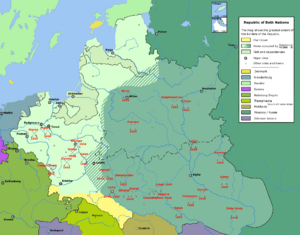
Despite these problems, Belarusian writing continued to grow. Until the 17th century, the Ruthenian language was used for official documents. After that, Polish became more common among the upper classes. Both Polish and Ruthenian cultures gained a major center when the Academy of Vilna was founded. At the same time, Belarusian lands saw economic growth. Many towns became important trade centers between east and west.
However, this growth ended in the mid-17th century with a series of wars. These included conflicts with the Tsardom of Russia, Sweden, and others. There were also internal conflicts, known as the Deluge. These troubles began in 1648 when Bohdan Khmelnytsky led a large Cossack uprising in Ukraine. Although the Cossacks were defeated in 1651, Khmelnytsky asked the Russian tsar for help. As a result of the Treaty of Pereyaslav, Russia controlled and partly occupied the eastern Commonwealth lands from 1655. The Swedes invaded and occupied the rest that same year.
These wars showed the country's internal weaknesses. Some people in the Grand Duchy supported Russia, while others supported the Swedes. The Swedes were eventually pushed back in 1657, and the Russians were defeated in 1662. But most of the country was in ruins. It's thought that the Commonwealth lost a third of its population. Some regions of Belarus lost as much as 50%. This weakened the Commonwealth, making it open to foreign influence.
Later wars, like the Great Northern War, further damaged the economy. Russian armies also raided the Commonwealth, claiming they were taking back runaway peasants. By the mid-18th century, Russian troops were almost always present in modern Belarus.
The last effort to save the Commonwealth's independence was the Kościuszko Uprising in 1794. It was a Polish–Belarusian–Lithuanian uprising led by Tadeusz Kościuszko, but it failed.
Finally, by 1795, Poland was divided by its neighbors. This began a new period in Belarusian history. All its lands were taken by the Russian Empire. Russian tsars wanted to "gather the Rus lands," a goal that started after they broke free from Tatar rule.
Russian Empire: Under Russian Rule


Under Russian rule, Belarus was split into different areas called guberniyas. These included Minsk, Vitebsk, Mogilev, and Grodno. Belarusians fought against Napoleon's occupation in 1812. After Napoleon's defeat, Belarus again became part of Imperial Russia. Uprisings by nobles in 1830 and 1863 were put down by Russian forces.
Under Tsars Nicholas I and Alexander III, national cultures were suppressed. This included policies to make people more Polish or Russian. There were also efforts to bring people back to the Orthodox faith. However, the 19th century also saw the rise of the modern Belarusian nation. Several authors began publishing in the Belarusian language. These included Jan Czeczot, Władysław Syrokomla, and Konstanty Kalinowski. In 1862-1863, Kalinowski published the first newspaper in modern Belarusian, Mużyckaja prauda (Peasants' Truth).
In the 1840s, as part of a Russification effort, Nicholas I banned the name Belarusia. He renamed the region the "North-Western Territory." He also stopped the use of Belarusian in public schools and tried to force Catholics to become Orthodox. In 1863, these pressures led to a revolt led by Kalinowski. After the revolt failed, the Russian government brought back the use of the Cyrillic alphabet for Belarusian in 1864. They also banned the use of the Latin alphabet.
In the second half of the 19th century, Belarus's economy grew. This was due to the Industrial Revolution spreading to Eastern Europe. This growth was especially strong after serfs were freed in 1861 and railways were built. Minsk, Vitebsk, Grodno, Pinsk, and Gomel became important industrial centers. Many peasants moved to industrial cities, with about 1.5 million people leaving Belarus in the 50 years before the Russian Revolution of 1917.
20th Century: Wars and New States
New Republics and Soviet Rule
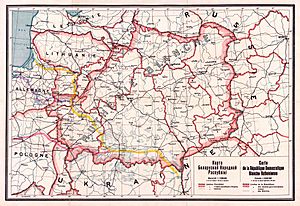

On February 21, 1918, German troops captured Minsk. World War I was a short time when Belarusian culture began to thrive. German rule allowed schools to teach in Belarusian, which Russia had previously banned. Many Belarusian schools were created until 1919, when Polish military rule banned them again. At the end of World War I, while Belarus was still occupied by Germans, the short-lived People's Republic of Belarus was declared on March 25, 1918.
In December 1918, Germany withdrew from Minsk. For the next few years, various groups fought for control of Belarus. On December 10, 1918, Soviet troops occupied Minsk. The Rada (Council) of the People's Republic of Belarus went into exile. On January 2, 1919, the Soviet Socialist Republic of Byelorussia was declared. It was later joined with the Lithuanian SSR to form the Lithuanian–Byelorussian Soviet Socialist Republic, known as Litbel. Its capital was Vilnius.
Polish forces captured Vilnius on April 17, 1919. The capital of Litbel moved to Minsk. On July 17, 1919, Lenin dissolved Litbel due to Polish pressure. Polish troops captured Minsk on August 8, 1919.
Dividing Belarus: Poland and the Soviet Union
During the Polish–Soviet War, Soviet forces re-captured Minsk on July 11, 1920. A new Byelorussian Soviet Socialist Republic was declared on July 31, 1920. Polish leader Józef Piłsudski then pushed back the Soviet advance at the Battle of Warsaw. The Treaty of Riga, which ended the war, divided Belarus between Poland and Soviet Russia.
The Polish part of Belarus faced policies to make people more Polish. Meanwhile, Soviet Belarus became one of the original republics of the USSR. For several years, Belarusian culture and language saw a revival in Soviet Belarus. However, this ended during the Great Purge. Almost all important Belarusian thinkers and artists were executed. Thousands were sent to Asia.
In West Belarus, up to 30,000 Polish veteran families settled on lands that once belonged to Russian nobles. By the early 1930s, the Polish government tried to make all minorities more Polish. The use of Belarusian was discouraged, and Belarusian schools faced money problems. By spring 1939, there were no official Belarusian organizations or schools left in Poland.
Belarus in World War II: Devastation and Resistance
When the Soviet Union invaded Poland on September 17, 1939, Western Byelorussia became part of the BSSR. This happened because of a secret agreement in the Molotov–Ribbentrop Pact. For a short time, Belarusian language and Soviet culture saw some growth.
On June 22, 1941, Nazi Germany and its allies invaded the Soviet Union. Soviet authorities quickly moved about 20% of Belarus's population away. Belarus suffered terribly during the fighting and German occupation. Minsk was captured by the Germans on June 28, 1941. By the end of August 1941, all of Belarus was under German control.
During World War II, the Nazis tried to set up a puppet Belarusian government. But in reality, the Germans created a very harsh regime. They burned about 9,000 Belarusian villages. They sent about 380,000 people away for forced labor. Hundreds of thousands more civilians were killed.
From the start of the occupation, a strong Belarusian resistance movement grew. Hiding in forests and swamps, these partisans badly damaged German supply lines. They blew up railway tracks and bridges, attacked supply depots, and ambushed German soldiers. Not all anti-German partisans supported the Soviets. In the largest partisan attack of the war, the Asipovichy diversion on July 30, 1943, four German trains with supplies and Tiger tanks were destroyed.
On June 22, 1944, the huge Soviet Operation Bagration began. Minsk was re-captured on July 3, 1944. All of Belarus was freed by the end of August.
In total, Belarus lost a quarter of its population during World War II. This included almost all its educated people. About 9,200 villages and 1.2 million houses were destroyed. Major cities like Minsk and Vitsebsk lost over 80% of their buildings. For its strong defense and resistance, Minsk was given the title Hero City after the war. The fortress of Brest was named a Hero-Fortress.
Belarusian Soviet Socialist Republic (BSSR) from 1945 to 1990
After the war ended in 1945, Belarus became one of the founding members of the United Nations Organisation. The Soviet Union itself and another republic, Ukraine, also joined.

More than 200,000 ethnic Poles left or were forced to move to Poland in the late 1940s and 1950s. Some were killed or sent to Siberia.
The Belarusian economy was completely destroyed by the war. Most industries and factories were moved to Russia or Germany. In 1945, Belarus's industrial production was less than 20% of what it was before the war. Most factories moved to Russia were not returned to Belarus. After the war, the Soviet Union rebuilt and expanded Belarus's economy. Control always came from Moscow. During this time, Belarus became a major manufacturing center in the western USSR. Huge factories like BelAZ, MAZ, and the Minsk Tractor Plant were built. More jobs led to many Russians moving to Belarus. Russian became the official language of government.
On April 26, 1986, the Chernobyl disaster happened at the Chernobyl Nuclear Power Plant in Ukraine. It was near the border with Belarus. This was the worst nuclear accident in history. It released a cloud of radioactive material that spread over parts of the Soviet Union, Eastern Europe, and Scandinavia. Large areas of Belarus, Ukraine, and Russia were contaminated. About 200,000 people had to be moved. About 60% of the radioactive fallout landed in Belarus. The effects of the Chernobyl accident in Belarus were huge. About 50,000 square kilometers (a quarter of Belarus's land) became contaminated. This area was home to 2.2 million people (a fifth of Belarus's population). These areas now need constant monitoring for radiation. 135,000 people were permanently moved. Ten years after the accident, cases of thyroid cancer in children increased fifteenfold.
Republic of Belarus: An Independent Nation
Becoming Independent
On July 27, 1990, Belarus declared its national sovereignty. This was a big step towards becoming independent from the Soviet Union. Around this time, Stanislav Shushkevich became the head of the Supreme Soviet of Belarus.
On August 25, 1991, after the August Coup failed in Moscow, Belarus declared full independence from the USSR. On December 8, 1991, Shushkevich met with Boris Yeltsin of Russia and Leonid Kravchuk of Ukraine. They met in Belavezhskaya Pushcha to officially declare the dissolution of the Soviet Union. They also formed the Commonwealth of Independent States.
The Lukashenko Era
A new Belarusian constitution was put in place in early 1994. This led to the first democratic presidential election on June 23 and July 10. Alexander Lukashenko was elected president of Belarus. He has been president since 1994, making him the longest-serving European president.
In December 1994, Lukashenko signed the Budapest Memorandum. This agreement was with Russia, the United Kingdom, and the United States. Belarus agreed to give up its nuclear weapons. In return, these countries promised to protect Belarus's security.
See also
 In Spanish: Historia de Bielorrusia para niños
In Spanish: Historia de Bielorrusia para niños



